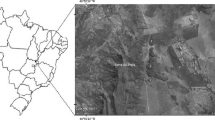Summary
Niche separation was studied in two sympatric sunbird species in the Kivu Highlands (Republic of Zaire, Africa).
Cyanomitra verticalis and Nectarinia kilimensis occur together in many parts of East and Central Africa and live, at least in the study area, in the same habitat.
Nectarinia kilimensis is somewhat bigger and heavier than Cyanomitra verticalis. Bill size and shape are almost identical; small differences cannot be attributed to ecological or other facts.
The food of both species consists of two different components. One of them is nectar (rich in carbohydrates) which they suck on flowers of shrubs and trees, especially on Erythrina tomentosa. No niche separation could be detected in their way of visiting flowers: they visit the same trees, often at the same time.
The other component (rich in protein) consists of arthropods which represent about 10%, maximally up to 30% of the food. Here both species differ in catching methods as well as in the systematic composition of the prey:
Cyanomitra verticalis searches on trunks and branches and collects predominantly spiders and cicada larvae;
Nectarinia kilimensis catches insects on the wing, especially ants, beetles and tipulids. Both species may be limited by their requirement of arthropods, for the following reasons:
-
1.
arthropod food is essential for both species and cannot be replaced by nectar;
-
2.
availability of arthropods is restricted because both species have only few stereotype behavioural mechanisms for catching arthropods. Furthermore, arthropods are an important food resource for many other animals.
It is proposed that the populations of Cyanomitra verticalis and Nectarinia kilimensis are limited by the arthropod supply in such a way that, in comparison, nectar is available in abundance. Thus, there is no competition for nectar. On the other hand, competition for arthropods, though present, is reduced by different feeding behaviour. Therefore Cyanomitra verticalis and Nectarinia kilimensis can coexist in the studied area.
Similar content being viewed by others
Literatur
Cummins, K. W., Wuycheck, J. C.: Caloric equivalents for investigations in ecological energetics. Stuttgart: Schweizerbarth 1971
Kendeigh, C. S.: Energy requirements for existence in relation to size of bird. Condor 72, 60–65 (1970)
Lack, D.: Ecological isolation in birds. Oxford-Edinburgh: Blackwell 1971
Mackworth-Praed, C. W., Grant, C. H. B.: Birds of Eastern and North-Eastern Africa. London: Longmans 1955
Spiegel, M. R.: Theory and problems of statistics. New York: Schaum's Outline Series 1961
Weichselberger, K.: Statistik II. Skriptum nach Vorlesungen, München (1971)
Williams, J. G.: A field guide to the birds of East and Central Africa. London: Collins 1969
Author information
Authors and Affiliations
Additional information
Mit Unterstützung des Deutschen Akademischen Austauschdienstes, Bonn.
Rights and permissions
About this article
Cite this article
Kramer, G. Nischentrennung beim grünkopfnektarvogel (Cyanomitra verticalis) und bronzenektarvogel (Nectarinia kilimensis) (Fam. Nectarinidae, Aves) im kivuhochland (Republik Zaire, Afrika). Oecologia 20, 143–156 (1975). https://doi.org/10.1007/BF00369027
Received:
Issue Date:
DOI: https://doi.org/10.1007/BF00369027




